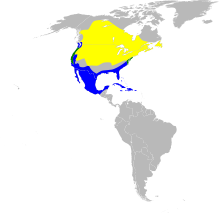| American bittern | |
|---|---|

| |
| Scientific classification | |
| Domain: | Eukaryota |
| Kingdom: | Animalia |
| Phylum: | Chordata |
| Class: | Aves |
| Order: | Pelecaniformes |
| Family: | Ardeidae |
| Genus: | Botaurus |
| Species: | B. lentiginosus
|
| Binomial name | |
| Botaurus lentiginosus | |

| |
| Range of B. lentiginosus Breeding range Year-round range Wintering range
| |
| Synonyms | |
| |
The American bittern (Botaurus lentiginosus) is a species of wading bird in the heron family. It has a Nearctic distribution, breeding in Canada and the northern and central parts of the United States, and wintering in the U.S. Gulf Coast states, all of Florida into the Everglades, the Caribbean islands and parts of Central America.
It is a well-camouflaged, solitary brown bird that unobtrusively inhabits marshes and the coarse vegetation at the edge of lakes and ponds. In the breeding season it is chiefly noticeable by the loud, booming call of the male. The nest is built just above the water, usually among bulrushes and cattails, where the female incubates the clutch of olive-colored eggs for about four weeks. The young leave the nest after two weeks and are fully fledged at six or seven weeks.
The American bittern feeds mostly on fish but also eats other small vertebrates as well as crustaceans and insects. It is fairly common over its wide range, but its numbers are thought to be decreasing, especially in the south, because of habitat degradation. However the total population is large, and the International Union for Conservation of Nature has assessed its conservation status as being of "Least Concern".
- ^ BirdLife International (2016). "Botaurus lentiginosus". IUCN Red List of Threatened Species. 2016: e.T22697340A93609388. doi:10.2305/IUCN.UK.2016-3.RLTS.T22697340A93609388.en. Retrieved 19 November 2021.
- ^ Lepage, Denis. "American Bittern Botaurus lentiginosus (Rackett, 1813)". Avibase. Retrieved 29 November 2015.
